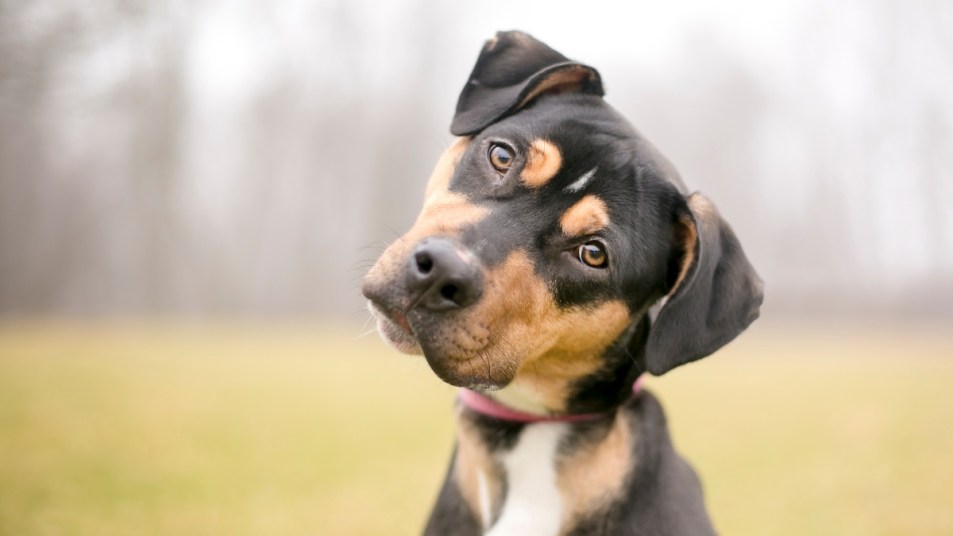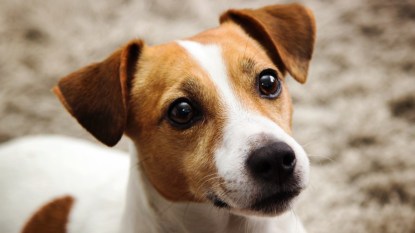Dogs Can’t See Clearly, Say Scientists — Here’s What New Studies Reveal About Your Pup’s Eyesight
The world according to dogs.

There’s a photo on the computer screen I’m looking at, but it’s blurry, dull, and discolored. There’s a grayness to it, and the faces are hard to make out. If I were my dog, this is how I would describe the wedding photo I’ve set as my computer’s screensaver.
I don’t have to imagine this, though. A new online tool that shows pet owners what photos look like from their dog’s point of view provides shocking insights. Created by programmer András Péter, Dog Vision allows you to upload any image you like and run any combination of three modifying filters on it to simulate its appearance to a dog.
Péter based his filters on what research has revealed about three key vision factors: color sensitivity, brightness discrimination, and visual acuity, or sharpness (which is what your eye doctor’s familiar chart measures). It turns out that dogs’ eyesight isn’t all that good, at least compared to ours.
The Way They See It
We can’t be certain about what dogs’ inner experiences are like, of course. “We’re asking about what’s going on covertly, so to speak, inside an animal’s head,” says Monique Udell, PhD, associate professor of animal and rangeland sciences at Oregon State University. We can’t ask them directly if they see red, for example, the way we do with people.
Researchers must devise clever means of “asking” dogs questions in laboratory experiments, putting them through a test or task, usually with a reward of some sort to motivate them. Then they look at how the dogs performed and see what might be reasonably inferred. To test visual acuity, for instance, scientists use an eye chart customized for dogs — not lines of progressively smaller letters, but rows of black and white vertical stripes.
They show each row to the dog alongside an equal-size row of plain gray, and if the dog can select the striped pattern, the pup gets a treat. With each row the stripes get narrower and narrower, and when the dog can’t distinguish the striped row from the gray, they’ve reached the limits of the dog’s visual acuity. But dogs, like people, aren’t all the same. “It’s very difficult to answer a question about the average dog,” Udell explains, “because the ‘average’ dog doesn’t exist.”
Dogs vary widely in size and shape, by breed and by life experience, and by simple personality, age, and individual capacity. Most studies involve only a handful of dogs, and “a lot of times breed isn’t even taken into account,” says Jeffrey Katz, PhD, professor of psychology at Auburn University. The most often cited measure of dogs’ visual acuity, for example, is based on a study of a single poodle.
Alternate Visual Fields
Still, we can say some things with a fair level of certainty. Dogs see colors, but not as many as humans do — they only have two types of color-sensing receptors, where humans have three. Like some colorblind people, dogs lack the receptor for red and green hues. They see yellows and blues and some combinations of those, but other colors come through as various browns and grays. Dogs also have far more difficulty than we do in differentiating between shades of the same color, and most breeds are nearsighted — though some, such as Labradors, often used as guide dogs, may approach the human equivalent of 20/20.
On the other hand, dogs’ vision is superior to ours in some ways. They see much better in dim light. And because most dogs’ eyes are located more toward the edges of their skulls, they have a wider range of peripheral vision — a 240 to 270-degree field of view, while humans have just 180 degrees.
A Soundscape With a Difference
A dog’s inner experience differs from ours because of other senses, too. Humans can typically hear sounds from around 20 Hz to 20,000 Hz. (Hertz [Hz] is a measure of a sound’s frequency, with higher frequencies equating to higher pitches.) But dogs hear sounds from about 40 Hz to as high as 60,000 Hz or even 75,000 Hz. (Study results have varied.)
Dogs are hearing things all the time that we are completely unaware of. And it’s not just that they hear a wider range of pitches. Dogs are also vastly more sensitive than humans to sounds in certain ranges, so they’re able to hear things that are simply too quiet for us to pick up on.
In fact, dogs have been reported to respond to sounds that are anywhere from 5 to 30 times quieter than what we humans can hear at all. Your dog can hear the chirping of mice in your basement and the rustling of beetles in the grass outside your home. Your beloved pooch may even be able to hear your heartbeat from far across the room.
An Extraordinary Sense of Smell
But where the dog’s inner world differs most radically from ours is in the realm of odors. Compared to dogs, humans are practically nose-blind. Where humans have roughly 6 million odor receptors in their nasal passages, dogs have anywhere from 100 million to 300 million receptors, depending on breed. They also have more types of receptors, so they’re able to detect some kinds of odor molecules that our noses simply ignore. Some have suggested that the most odor-sensitive breeds such as bloodhounds and beagles are a million times better at detecting odors than we are. One researcher speculates that a dog could probably detect a single rotten apple in a warehouse full of 2 million barrels.
The difference is so vast that it can be hard to imagine what odor means to the inner experience of a dog. Odor for us is a distinctly adjunct sense, something we use to add a layer of detail to certain parts of our world. We sniff a flower or a pot of soup, but we don’t think of the couch as giving off a characteristic odor, or notice the distinctive scent from each of the plants in the pots on the windowsill when we walk into the room. Dogs, on the other hand, “experience a rich, three-dimensional world of odors,” says Katz.
Everything for them has a unique scent — trained dogs can distinguish identical twins based on smell alone — and they can derive a vast array of information from all those odors. Dogs can smell the chemical changes in your body that indicate sadness, stress, or fear. They can smell the places you’ve been on your shoes and clothes, smell the things you’ve eaten today, and detect the scent of the cat you stopped and petted on your way to work.
Stronger Senses
Dogs can also draw conclusions from the tiniest differences in the strength of a scent. In
an experiment at the Animal Behaviour Centre at Queen’s University Belfast in Northern Ireland, researchers had a person walk a path along squares of carpet laid out on the ground, leaving a single footprint on each square. An hour later, they brought dogs to the trail (one at a time), and found that the dogs could determine which way the person had gone with as few as five footprints to work from.
Older steps would have slightly weaker scents than more recent ones, as the odor molecules diffuse into the air. Those minuscule differences in scent concentration were all the dogs needed. Though the canine sense of smell is extraordinary, most dogs navigate the world by combining all of their senses, from olfaction to vision to hearing, explains Udell. “It’s hard for us to conceive of, precisely, since vision takes such a distinct precedence in our inner lives, but dogs may have a more blended sensory experience. It will take more research to find out.” In the meantime, what we can be sure of is that to a dog, the world is a vastly smellier, noisier, blurrier, and less colorful place than it is for us.
Seeing With Scent?
Some people contend that for dogs, scent plays essentially the same role that vision does for most of us. But there’s good reason to be cautious in the face of an assertion like this. Light and odor don’t behave the same way. Light travels in straight lines until there is a blockage. Odor molecules drift on air currents and disperse over time. And the two senses don’t provide equivalent information. It might be difficult, for instance, to rely on scent to navigate while running through a tree-filled park or a yard strewn with toys and folding chairs. Of course, highly trained vapor-detection dogs that can pick up the scent of explosives being carried by people just walking past them might be an exception here.
These canines can trace an odor trail quickly to the moving source. “They’re experiencing this world with all these odors going by just like you see all the photons of light that are hitting your retina,” psychology professor Jeffrey Katz, PhD, says. But such a refined ability appears to be limited to dogs that have gone through rigorous training. Most canines still rely mightily on the sense of vision to navigate the world.
A version of this article appeared in our partner magazine, Inside Your Dog’s Mind, in 2021.













